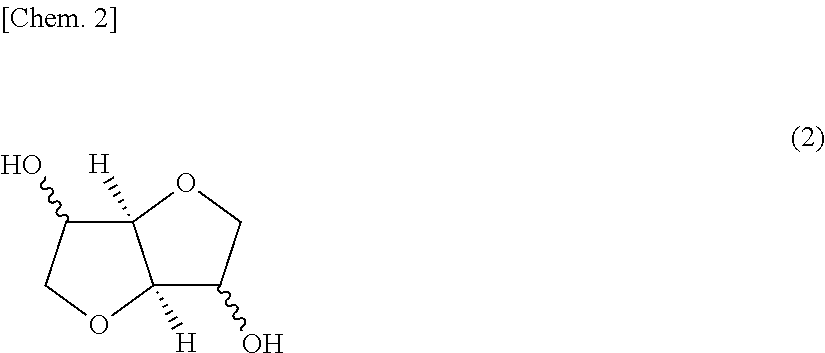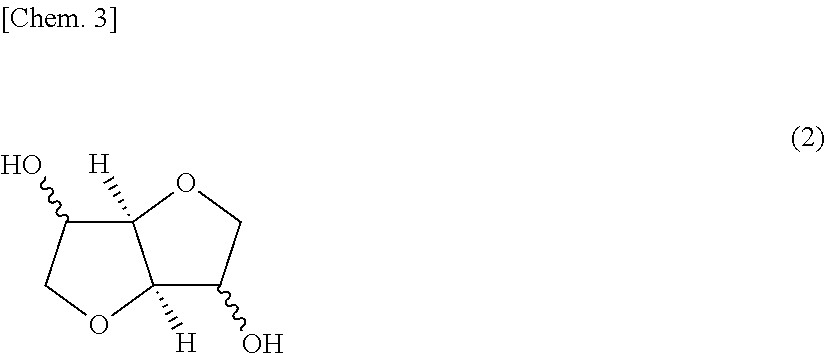Polycarbonate resin compositions and molded articles
a technology of polycarbonate resin and composition, which is applied in the direction of chemical recycling, etc., can solve the problems of deterioration of hue, transparency, or mechanical strength of polycarbonate resin, limited outdoor use of polycarbonate resin, etc., and achieve excellent light resistance, transparency, heat resistance, thermal stability, mechanical strength, excellent light resistance
- Summary
- Abstract
- Description
- Claims
- Application Information
AI Technical Summary
Benefits of technology
Problems solved by technology
Method used
Image
Examples
production example 1
Production of Polycarbonate Resin (A)
[0234]Into a polymerizer equipped with a stirrer and a reflux condenser regulated so as to have a temperature of 100° C. were introduced ISB, CHDM, DPC which had been purified by distillation to a chloride ion concentration of 10 ppb or less, and calcium acetate monohydrate so that the ISB / CHDM / DPC / calcium acetate monohydrate molar ratio was 0.50 / 0.50 / 1.00 / 6.5×10−7. Nitrogen displacement was sufficiently conducted.
[0235]Subsequently, the contents were heated with a heat medium, and stirring was initiated at the time when the internal temperature reached 100° C. While regulating the system so as to maintain the internal temperature of 100° C., the contents were melted and homogenized. Thereafter, heating was initiated to elevate the internal temperature to 210° C. over 40 minutes. At the time when the internal temperature reached 210° C., the system was regulated so as to maintain the temperature and, simultaneously therewith, pressure reduction w...
production example 2
Production of Polycarbonate Resin (A)
[0239]Into a polymerizer equipped with a stirrer and a reflux condenser regulated so as to have a temperature of 100° C. were introduced ISB, CHDM, DPC which had been purified by distillation to a chloride ion concentration of 10 ppb or less, and cesium carbonate so that the ISB / CHDM / DPC / cesium carbonate molar ratio was 0.50 / 0.50 / 1.00 / 2.4×10−6. Nitrogen displacement was sufficiently conducted.
[0240]Subsequently, the contents were heated with a heat medium, and stirring was initiated at the time when the internal temperature reached 100° C. While regulating the system so as to maintain an internal temperature of 150° C., the contents were melted and homogenized. Subsequently, the pressure was reduced from ordinary pressure to 13.3 kPa, and the internal temperature was thereafter elevated to 190° C. over 60 minutes. After the internal temperature had reached 190° C., the contents were held for 15 minutes.
[0241]The phenol vapor which generated as a ...
example 1-1
[0244]Into a polymerizer equipped with a stirrer and a reflux condenser regulated so as to have a temperature of 100° C. were introduced ISB, CHDM, DPC which had been purified by distillation to a chloride ion concentration of 10 ppb or less, and calcium acetate monohydrate so that the ISB / CHDM / DPC / calcium acetate monohydrate molar ratio was 0.69 / 0.31 / 1.00 / 1.3×10−6. Nitrogen displacement was sufficiently conducted (oxygen concentration, 0.0005-0.001 vol %). Subsequently, the contents were heated with a heat medium, and stirring was initiated at the time when the internal temperature reached 100° C. While regulating the system so as to maintain the internal temperature of 100° C., the contents were melted and homogenized.
[0245]Thereafter, heating was initiated to elevate the internal temperature to 210° C. over 40 minutes. At the time when the internal temperature reached 210° C., the system was regulated so as to maintain the temperature and, simultaneously therewith, pressure reduc...
PUM
| Property | Measurement | Unit |
|---|---|---|
| temperature | aaaaa | aaaaa |
| thickness | aaaaa | aaaaa |
| thickness | aaaaa | aaaaa |
Abstract
Description
Claims
Application Information
 Login to View More
Login to View More - R&D
- Intellectual Property
- Life Sciences
- Materials
- Tech Scout
- Unparalleled Data Quality
- Higher Quality Content
- 60% Fewer Hallucinations
Browse by: Latest US Patents, China's latest patents, Technical Efficacy Thesaurus, Application Domain, Technology Topic, Popular Technical Reports.
© 2025 PatSnap. All rights reserved.Legal|Privacy policy|Modern Slavery Act Transparency Statement|Sitemap|About US| Contact US: help@patsnap.com



